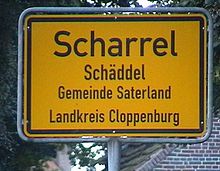Saterland Frisian language
error: ISO 639 code is required (help)
Saterland Frisian, also known as Sater Frisian or Saterlandic (Seeltersk), is the last living dialect of the East Frisian language. It is closely related to the other Frisian languages, North Frisian, which, like Saterland Frisian is spoken in Germany, and West Frisian, which is spoken in the Netherlands.

Old East Frisian and its decline
Old East Frisian used to be spoken in East Frisia (Ostfriesland), the region between the Dutch border and the river Weser, in the German state of Lower Saxony. The area also included two small districts on the east bank of the Weser, the lands of Wursten and Würden. The Old East Frisian language could be divided into two dialect groups: Weser Frisian to the east, and Ems Frisian to the west. From 1500 onwards Old East Frisian slowly had to give way to the severe pressure put on it by the surrounding Low German dialects, and nowadays it is all but extinct.
By the middle of the seventeenth century Ems Frisian had almost completely died out. Weser Frisian for the most part did not last much longer and held on only until 1700, although there are records of it still being spoken in the land of Wursten, to the east of the river Weser, in 1723. It held out the longest on the island of Wangerooge, where the very last Weser Frisian speaker was recorded as having died in 1953. Today, the Old East Frisian language is no longer spoken within the historical borders of East Frisia, yet a large number of the inhabitants of that region still consider themselves Frisians and refer to their dialect of Low German as Freesk. In this dialect, referred to as Ostfriesisch in German, the Frisian substratum is still evident.
Sater Frisian
The last remaining living remnant of Old East Frisian is an Ems Frisian dialect called Sater Frisian or Saterlandic (its native name being Seeltersk), which is spoken in the Saterland area in the Verwaltungsbezirk Oldenburg, to the south of East Frisia proper. Saterland (Seelterlound in the local language), which is believed to have been colonised by Frisians from East Frisia in the eleventh century, was for a long time surrounded by impassable moors. This, together with the fact that Sater Frisian always had a status superior to Low German among the inhabitants of the area, accounts for the preservation of the language throughout the centuries.
Another important factor might be that after the Thirty Years' War, Saterland became part of the bishopric Münster. As a consequence it was brought back to the Catholic Church, resulting in isolation from main East-Frisia since about 1630. So e.g. marriages were no longer contracted with people from the north.
Speakers
Today, estimates of the number of speakers vary slightly. Sater Frisian is spoken by approximately 2,250 people, out of a total population of the Saterland area of some 10,000. An estimated 2,000 people might speak the language well, of which slightly less than a half are native speakers. The vast majority of all native speakers are found among the elder generation; Saterlandic thus is a seriously endangered language. It might, however, no longer be moribund, since several reports suggest the number of acquired speakers is rising among the younger generation and some of them raise their children in Saterlandic.
Dialects
There are three fully mutually intelligible dialects, corresponding to the three main villages of the municipality of Saterland: Ramsloh (Saterlandic: Roomelse), Scharrel (Schäddel), and Strücklingen (Strukelje). The Ramsloh dialect now somewhat enjoys a status as standard language, since a grammar and a word list were based on it.
Status
The German government apparently thinks the preservation of Sater Frisian is a lost cause, and seems to be unwilling to invest much money or energy in it. Most of the work to secure the endurance of this language is therefore done by the Seelter Buund ("Saterlandic Alliance"). Along with North Frisian and five other languages, Sater Frisian was included in Part III of the European Charter for Regional or Minority Languages by Germany in 1998.
Since about 1800, Sater Frisian has attracted the interest of a growing number of linguists. During the last century, a small literature developed in it. Also the New Testament of the Bible has been translated into Sater Frisian.
Specimen
Saterland Frisian: Die Wänt strookede dät Wucht uum ju Keeuwe un oapede hier ap do Sooken.
North Frisian (Mooring): Di dreng aide dåt foomen am dåt kan än mäket har aw da siike.
West Frisian: De jonge streake it famke om it kin en tute har op 'e wangen.
East Frisian Low Saxon: De Jung straktde dat Wicht üm't Kinn to un tuutjede hör up de Wangen.
Dutch: De jongen aaide het meisje over haar kin en kuste haar op haar wangen.
German: Der Junge streichelte das Mädchen ums Kinn und küsste sie auf die Wangen.
English: The boy stroked the girl on the chin and kissed her on the cheeks.
